Frank's travels around Britain 2009.
New Forest.
 Centred
at the Travel Lodge at Barton Stacey near Andover, I was ideally placed to drop down into the New Forest.
It's another
area of thatched cottages in small villages with price tags to make your eyes
water. Once again the Gods decided to smile down on me & send perfect weather
for two days. Perhaps they thought the last trip was punishment enough.
Centred
at the Travel Lodge at Barton Stacey near Andover, I was ideally placed to drop down into the New Forest.
It's another
area of thatched cottages in small villages with price tags to make your eyes
water. Once again the Gods decided to smile down on me & send perfect weather
for two days. Perhaps they thought the last trip was punishment enough.
I found a house & garden that was, at one time, an Abbey called Mottisfont. On the way there, the small country roads lead through pretty villages, one of which was Wherwell. At last I found a place that looked a little lived in. There was a war memorial, a hairdressers & a pub! There were even people that were actually walking about (well one or two). That's not a common occurrence now-a-days, with every one commuting. No one walks & cottages all look like they are holiday lets, the true country village always appears deserted. We shouldn't say that no one really lives there, it just looks like a film set & the extras are all round the back having lunch. To own an old cottage, that was thatched to save on expensive tiles and inhabited by agricultural labourers, is expensive beyond belief. They are often breathtakingly beautiful & look like a picture postcard. No wonder tourists like me wander around, camera in hand trying to do them justice!
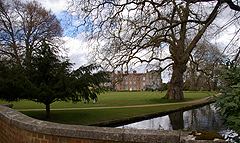 Mottisfont Abbey has its feet in the 12th century,
but claiming to have
the relic of St. John the Baptists finger did not protect it from the Black
Death.
According to the National Trust website;
"The
original building was a priory, founded by William Briwere in 1201. He was a
trusted adviser to Richard the Lionheart, King John and Henry III, and he was
one of the barons who signed the Magna Carta. At the dissolution of the
Monasteries the priory was acquired by William Lord Sandys, who converted it to
a house. Mottisfont passed in 1684 to Sir John Mill, nephew of the last Lord
Sandys. Sir John's second son, Sir Richard, the 5th Baronet and an MP from
1721-1747, succeeded in 1706. It was he who transformed the Tudor house
substantially to the form we see today, at least on the exterior".
Mottisfont Abbey has its feet in the 12th century,
but claiming to have
the relic of St. John the Baptists finger did not protect it from the Black
Death.
According to the National Trust website;
"The
original building was a priory, founded by William Briwere in 1201. He was a
trusted adviser to Richard the Lionheart, King John and Henry III, and he was
one of the barons who signed the Magna Carta. At the dissolution of the
Monasteries the priory was acquired by William Lord Sandys, who converted it to
a house. Mottisfont passed in 1684 to Sir John Mill, nephew of the last Lord
Sandys. Sir John's second son, Sir Richard, the 5th Baronet and an MP from
1721-1747, succeeded in 1706. It was he who transformed the Tudor house
substantially to the form we see today, at least on the exterior".
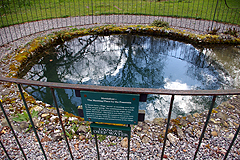 On
the outside it is lovely. The gardens are attractive with the River Test running
through its grounds. The original natural spring that attracted the monks here in the first place, still survives. Apparently in Saxon Times,
village "Moots" or meeting were held by the spring itself. It was a font of
water that even in very arid times, it never seemed to run dry & may have given
the place its name. The National
Trust took Mottisfont over in 1957 & it is now the home for the famous collection of
historic shrub roses created by Graham Stuart Thomas. The collection has been
registered as the National Collection of ancestral species and 19th-century rose
cultivars by the National Council for the Conservation of Plants and Gardens.
On
the outside it is lovely. The gardens are attractive with the River Test running
through its grounds. The original natural spring that attracted the monks here in the first place, still survives. Apparently in Saxon Times,
village "Moots" or meeting were held by the spring itself. It was a font of
water that even in very arid times, it never seemed to run dry & may have given
the place its name. The National
Trust took Mottisfont over in 1957 & it is now the home for the famous collection of
historic shrub roses created by Graham Stuart Thomas. The collection has been
registered as the National Collection of ancestral species and 19th-century rose
cultivars by the National Council for the Conservation of Plants and Gardens.
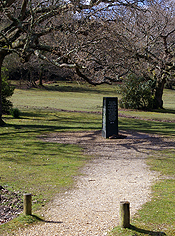 England
is full of tiny surprises. On the map it said "The Rufus Stone" ... who or
what
was Rufus & why a stone? There are signs for it everywhere & when you get there
... its a cast iron Triangle!
England
is full of tiny surprises. On the map it said "The Rufus Stone" ... who or
what
was Rufus & why a stone? There are signs for it everywhere & when you get there
... its a cast iron Triangle!
Considering the story happened on 2nd august 1100, its tale has grown over the years! On the marker, there are three sides. They say:
Side 1. Here stood the oak tree, on which an arrow shot by Sir Walter Tyrrell at a stag, glanced and struck King William the Second, surnamed Rufus, on the breast, of which he instantly died, on the second day of August, Anno 1100.
Side 2. King William the Second surnamed Rufus being slain, as before related, was laid in a cart, belonging to one Purkis, and drawn from hence, to Winchester, and buried in the cathedral church, of that city.
Side 3. That the spot where an event so memorable might not hereafter be forgotten; the enclosed stone was set up by John Lord Delaware who had seen the tree growing in this place. (The third side goes on to state) This stone having been much mutilated, and the inscriptions on each of its three sides defaced, this more durable memorial with the original inscriptions was erected in the year 1841, by Wm Sturges Bourne - Warden.
The full details on the
Rufus Stone website are worth reading. It's nowhere near as straight
forwards as it makes out on the triangle!
Two of the days were delightful, sunny weather, cold clean air & spring was out everywhere. One day I decided to have coffee & toast at the now famous Popham Little Chef of TV fame. What difference had chef Heston Blumenthal made to this institution? Well it certainly was a revamp! Do you like your Little chef to be an American Diner, sky painted ceiling, music in the toilets or do you prefer it in it's old clothes but re-decorated? I was no judge of the food, as I am the original church mouse but its staffed by some very nice, well trained/naturally welcoming people. Its bright, modern & pleasant but as I type, still no decision has been made to see if this is the Chef of the future. Both this one & Barton Stacey had very nice people running it. The rest of the Little Chef outlets just needs a systematic overhaul. It's so obvious now. Chair covers are coming apart, everywhere is clean but really worn. Will they make enough profit to carry on following Popham's example or was Heston a quick shot in the arm to get the Little Chef promoted & get mass advertising by doing it all on telly?
There are two main towns as you go north to south across the New Forest. Lyndhurst is one, very nice, it's for tourists & ladies who shop and the other is Brockenhurst, no doubt very similar. Now I don't shop, so a place selling English lace & a full quote of charity shops aren't aimed at me BUT Brockenhurst had a wonderful surprise for me.
The parish church of St. Nicholas dates back to
Christians having worshipped on the site since AD737. The Domesday Book records
the church as being in "Broceste", as the Normans called Brockenhurst, and it is
regarded as the oldest church in the Forest, standing on top of a hill
overlooking the Village. Inside it's grave yard is moving piece of evidence from
The Great War.
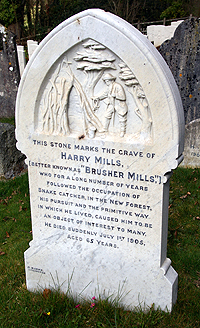
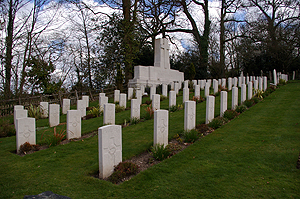 Imagine
you are a young man, full of vim & vigour. You are outraged at the nasty Hun &
want to join up & fight for King & Country. Unfortunately, your living in New Zealand at
the time! You have to travel for weeks by ship, bravely go to this foreign field
call Europe to do your bit. You are wounded & get transported to Brockenhurst,
Southern England
between 1916 and 1918, because the No.1 New Zealand General Hospital was based at
three sites around the town. At its height it had a staff of over 300 and
admitted, on average, around 26 patients a day.
The Imperial War Graves Commission now cares for 100 soldiers graves, among them
93 New Zealanders, 1 Australian and 3 Indians. These men were among the
thousands of casualties of the first World War brought from France for treatment
but didn't survive. They can all rest easy, as, just in front of them is the
grave of Harry "Brusher"
Mills, the local snake catcher, who seems to be guarding them from the local
wild life. It may have been of little consolation to their mothers & fathers
across the oceans, but it is beautifully kept & a quiet, peaceful place to spend
the rest of eternity. My contacts with New Zealand made it a very moving experience. It was
a long way to come to not make it back home.
Imagine
you are a young man, full of vim & vigour. You are outraged at the nasty Hun &
want to join up & fight for King & Country. Unfortunately, your living in New Zealand at
the time! You have to travel for weeks by ship, bravely go to this foreign field
call Europe to do your bit. You are wounded & get transported to Brockenhurst,
Southern England
between 1916 and 1918, because the No.1 New Zealand General Hospital was based at
three sites around the town. At its height it had a staff of over 300 and
admitted, on average, around 26 patients a day.
The Imperial War Graves Commission now cares for 100 soldiers graves, among them
93 New Zealanders, 1 Australian and 3 Indians. These men were among the
thousands of casualties of the first World War brought from France for treatment
but didn't survive. They can all rest easy, as, just in front of them is the
grave of Harry "Brusher"
Mills, the local snake catcher, who seems to be guarding them from the local
wild life. It may have been of little consolation to their mothers & fathers
across the oceans, but it is beautifully kept & a quiet, peaceful place to spend
the rest of eternity. My contacts with New Zealand made it a very moving experience. It was
a long way to come to not make it back home.
For my friends in New Zealand, I understand there is a book written about it. The book is available from :
Clare Church, 113 Milford Road, Lymington, Hampshire, SO41 8DN. England
Tel: 01590 673145, email church@southern32.freeserve.co.uk.
Price: £10 + £4.50 p & p UK. NZ$48 (surface mail) or NZ$68 (airmail)
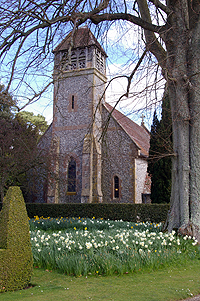
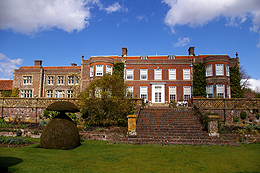 I
went off in search of more photographs of spring & found Hinton Ampner, a
beautiful Georgian house that actually looks like you'd like to live in it. It
has the
All Saints parish church standing next to the orchard, the church's origins are
Saxon. The chancel was rebuilt before 1822, and the nave by Ralph Dutton's
grandfather in the 1870s, when the French-style bell-tower was also added. Ralph
Dutton and many of his ancestors are buried in this beautiful church yard
in the stunning grounds. It is in the heart of this lovely countryside. The
current house was built in 1793 but remodelled extensively in 1867. It was then
resorted to it's original state in 1935, before being extensively damaged by
fire in 1960. Of
course there is no sign of damage now, The gardens were the personal vision of
Ralph Dutton, 8th and last Lord Sherbourne
(of course no
mention is made of the people who actually did the work!) It is definitely worth
strolling around here. I would think that every season will provide you with
another vista.
I
went off in search of more photographs of spring & found Hinton Ampner, a
beautiful Georgian house that actually looks like you'd like to live in it. It
has the
All Saints parish church standing next to the orchard, the church's origins are
Saxon. The chancel was rebuilt before 1822, and the nave by Ralph Dutton's
grandfather in the 1870s, when the French-style bell-tower was also added. Ralph
Dutton and many of his ancestors are buried in this beautiful church yard
in the stunning grounds. It is in the heart of this lovely countryside. The
current house was built in 1793 but remodelled extensively in 1867. It was then
resorted to it's original state in 1935, before being extensively damaged by
fire in 1960. Of
course there is no sign of damage now, The gardens were the personal vision of
Ralph Dutton, 8th and last Lord Sherbourne
(of course no
mention is made of the people who actually did the work!) It is definitely worth
strolling around here. I would think that every season will provide you with
another vista.
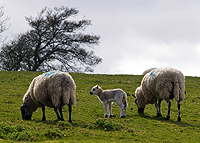 On a website about the two villages of Hinton Ampner & Bramdean
you see the amazing statement in 2009, " The current population of Hinton Ampner
is around 550, residing in approximately 190 houses. The majority of these
houses have no mains gas or drainage". And I bet they still cost an arm &
a leg!
On a website about the two villages of Hinton Ampner & Bramdean
you see the amazing statement in 2009, " The current population of Hinton Ampner
is around 550, residing in approximately 190 houses. The majority of these
houses have no mains gas or drainage". And I bet they still cost an arm &
a leg!
The New Forest is a former royal hunting area. It was created in 1079 by William I (known as William the Conqueror) for the hunting of mainly deer. It is a unique area of historical, ecological and agricultural significance, and retains many of the rural practices conceded by the Crown in historical times to local people. Principal of these is the pasturing of ponies, cattle, pigs and donkeys in the open Forest by local inhabitants known as commoners. The New Forest has also been an important source of timber for the Crown.
Links for
information on this page:
